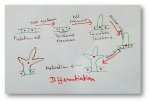Matter and Materials
We know that matter is substance which has weight and occupies space. All things that have weight and takes up space are called matter.
All living things such as animals, birds and plants, and non living things such as a bat, a pencil, a piece of wood, water or air are matter. So, all the things are made of matter.
The amount of space matter takes up is called its volume. Matter has weight and takes up space because it is made up of tiny particles. These particles are much smaller than a grain of sand and they are so small that we cannot see them. Millions and millions of these tiny particles together form a table or an animal or a human being. These very tiny particles are called molecules. Molecules are not visible to our naked eyes. Molecules of different kinds of matter have different size shape and weight. For example, the molecules of apple are different from that of sugar.
Molecules of different substances are different from each other. All molecules of a particular substance keep on moving constantly. Vacant spaces lies between the molecules. The space between the molecules of a matter is called inter-molecular space.
From Matter and Materials to HOME PAGE
Recent Articles
-
Differentiation, Dedifferentiation and Redifferentiation | Definition
Apr 21, 25 01:16 PM
Cells from the root apical meristem and shoot apical meristem the camera that differentiate , mature to perform different functions. This process by which the cells undergo different major structural… -
Explain about Growth in Plants |Definition of Growth & Differentiation
Feb 27, 25 02:07 PM
Growth is a permanent increase in length or volume of an organism that brought upon by an increase in its dimensions due to synthesis of new protoplasmic material. -
Definition of Respiratory Quotient | calculation | Application | Plant
Dec 02, 24 12:09 AM
Definition of respiration quotient- the ratio of the carbon-dioxide evolved to that of the oxygen consumed by a cell, tissue, plants or animals in a given time is called respiratory quotient. It is us… -
Amphibolic Pathway | Definition | Examples | Pentose Phosphate Pathway
Jun 06, 24 10:40 AM
Definition of amphibolic pathway- Amphibolic pathway is a biochemical pathway where anabolism and catabolism are both combined together. Examples of amphibolic pathway- there are different biochemical… -
Respiratory Balance Sheet | TCA Cycle | ATP Consumption Process
Feb 18, 24 01:56 PM
The major component that produced during the photosynthesis is Glucose which is further metabolised by the different metabolic pathways like glycolysis, Krebs cycle, TCA cycle and produces energy whic…




New! Comments
Have your say about what you just read! Leave me a comment in the box below.